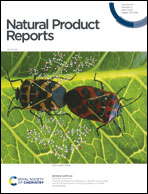Recent advances in the synthesis of insect pheromones: an overview from 2013 to 2022
Abstract
Covering: 2013 to June 2022
Pheromones are usually produced by insects in sub-microgram amounts, which prevents the elucidation of their structures by nuclear magnetic resonance (NMR). Instead, a synthetic reference material is needed to confirm the structure of the natural compounds. In addition, the provision of synthetic pheromones enables large-scale field trials for the development of environmentally friendly pest management tools. Because of these potential applications in pest control, insect pheromones are attractive targets for the development of synthetic procedures and the synthesis of these intraspecific chemical messengers has been at the core of numerous research efforts in the field of pheromone chemistry. The present review is a quick reference guide for the syntheses of insect pheromones published from 2013 to mid-2022, listing the synthesized compounds and highlighting current methodologies in organic synthesis, such as carbon–carbon coupling reactions, organo-transition metal chemistry including ring-closing olefin metathesis, asymmetric epoxidations and dihydroxylations, and enzymatic reactions.

- This article is part of the themed collection: Volatile Natural Products


 Please wait while we load your content...
Please wait while we load your content...